

Search the Journey to Forever website – click HERE

Navigation
|
Wood fires that fit
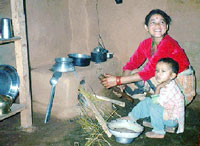
Improved chulha stove in India (FAO) |
Introduction
Indoor air pollution
Improved stoves
Wood-gas stoves
Charcoal
Resources
Half of humanity cooks over woodfires -- the poorer half. Nearly half the world's wood supply is used as fuel.
But it's not enough -- more than 2 billion people are facing fuelwood shortages. Forests in the developing countries are shrinking by more than 15 million hectares a year. The ratio of forests-to-people is less than half what it was in 1960.
For most, there's little alternative to burning wood -- wood energy is here to stay.
In fact burning wood is no bad thing: the efficient use of wood fuel is much more eco-friendly than more efficient and convenient fuels like kerosene and natural gas (LPG). LPG emits 15 times more CO2 (carbon dioxide) per kg than wood, and kerosene nearly 10 times as much. CO2 is the main source of global warming.
And as long as wood burning is sustainable and doesn't cause deforestation, its CO2 emissions are neutral -- the CO2 released in the fire simply gets recycled back into more trees.
In fact the evidence shows that woodfuel use is not a major cause of deforestation (the main causes are commercial logging and pressure for more farmland). About two-thirds of all woodfuel comes from non-forest land. People who depend on woodfuel maintain the trees that provide it, they don't cut them down. See the UN FAO's Regional Wood Energy Development Programme in Asia (RWEDP) website for more information:
http://www.rwedp.org/index.html
Misconceptions About Wood Energy, Wood Energy News, Vol. 12 No. 2, FAO-RWEDP, 1997
No Substitution of Traditional Fuels, Dr. W.S. Hulscher, , Bangkok, Wood Energy News, Vol. 12 No. 2, FAO-RWEDP, 1997: "It is widely assumed that increased penetration of modern fuels in developing countries implies a process of fuel transition (or fuel shift or fuel substitution), away from traditional fuels and towards modern fuels. A related assumption is that such a shift depends on per capita GNP, and further assumptions are that this fuel shift can and should be promoted by development efforts. These assumptions are not always right..."
Indoor air pollution
Nonetheless, most woodfires and cooking stoves are inefficient -- they waste energy, and they pollute the atmosphere both indoors and out.
The World Health Organization (WHO) and the United Nations Development Programme (UNDP) marked World Rural Women's Day on 15 October 2004 by drawing attention to Indoor Air Pollution -- one of the major causes of death and disease in the world's poorest countries. Smoke from cooking fires "gives off a poisonous cocktail of particles and chemicals that bypass the body's defences and more than doubles the risk of respiratory illnesses such as bronchitis and pneumonia. The indoor concentration of health-damaging pollutants from a typical wood-fired cooking stove creates carbon monoxide and other noxious fumes at anywhere between seven and 500 times over the allowable limits." WHO/UNDP statement on indoor air pollution, World Rural Women's Day 2004:
http://www.energyandenvironment.undp.org/undp/index.cfm?module=
Library&page=Document&DocumentID=5729
 Indoor smoke causes pneumonia and other respiratory infections, the biggest killer of children under five years of age. Indoor air pollution is responsible for nearly half of the more than 2 million deaths each year that are caused by acute respiratory infections. Inheriting the world: The atlas of children's health and the environment, by Bruce Gordon, Richard Mackay and Eva Rehfuess, WHO 2004, gives a graphic view of the problem. See Chapter 9, "Indoor Smoke: Breaking Down Respiratory Defences" (pdf 498kb): Indoor smoke causes pneumonia and other respiratory infections, the biggest killer of children under five years of age. Indoor air pollution is responsible for nearly half of the more than 2 million deaths each year that are caused by acute respiratory infections. Inheriting the world: The atlas of children's health and the environment, by Bruce Gordon, Richard Mackay and Eva Rehfuess, WHO 2004, gives a graphic view of the problem. See Chapter 9, "Indoor Smoke: Breaking Down Respiratory Defences" (pdf 498kb):
http://www.who.int/entity/ceh/publications/09indoorsmoke.pdf
Download the full document -- Inheriting the world (pdf 9.83Mb):
http://www.who.int/entity/ceh/publications/en/atlas.pdf
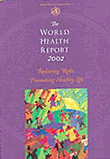 Indoor smoke pollution now ranks 8th in health burden worldwide (lost years of healthy life), and ranks fourth in the "least-developed" countries (which make up about 40% of the world population), according to the World Health Organization's World Health Report 2002. "Half the world's population is exposed to indoor air pollution, mainly the result of burning solid fuels for cooking and heating. Globally, it is estimated to cause 36% of all lower respiratory infections and 22% of chronic obstructive pulmonary disease." See World Health Report 2002: Indoor smoke pollution now ranks 8th in health burden worldwide (lost years of healthy life), and ranks fourth in the "least-developed" countries (which make up about 40% of the world population), according to the World Health Organization's World Health Report 2002. "Half the world's population is exposed to indoor air pollution, mainly the result of burning solid fuels for cooking and heating. Globally, it is estimated to cause 36% of all lower respiratory infections and 22% of chronic obstructive pulmonary disease." See World Health Report 2002:
http://www.who.int/whr/2002/en/index.html
 Smoke -- the killer in the kitchen: Smoke in the home from cooking on wood, dung and crop waste kills nearly one million children a year. The total annual death toll is 1.6 million -- a life lost every 20 seconds. Acute respiratory infections, ear and eye problems, breathlessness, chest pains, headaches and giddiness are just some of the symptoms poor woman and children suffer in their homes. Smoke -- the Killer in the Kitchen: Indoor Air Pollution in Developing Countries, Practical Action, 2004: Smoke -- the killer in the kitchen: Smoke in the home from cooking on wood, dung and crop waste kills nearly one million children a year. The total annual death toll is 1.6 million -- a life lost every 20 seconds. Acute respiratory infections, ear and eye problems, breathlessness, chest pains, headaches and giddiness are just some of the symptoms poor woman and children suffer in their homes. Smoke -- the Killer in the Kitchen: Indoor Air Pollution in Developing Countries, Practical Action, 2004:
http://practicalaction.org/?id=smoke_background
Read full report online:
http://practicalaction.org/?id=smoke_report_home#Contents
Download full report (4.7Mb Acrobat file):
http://practicalaction.org/docs/smoke/itdg%20smoke%20report.pdf
Buy book at Amazon.com: Smoke -- the Killer in the Kitchen
There's no single answer -- like most development and environment issues, it needs an integrated approach. Cheap, simple and effective solar box cookers have great potential, but again they are only part of the solution (see Solar box cookers).
Initiatives such as agroforestry for small farms (see Farming with trees) and people-centred forestation projects rather than industrial plantations are taking effect and have great promise (see Trees, soil and water).
The forestation projects that work best are the grassroots-level projects that involve local communites at every level. When they're in control, local people maintain the forests they depend on, and the main thing they depend on them for is usually firewood (one reason alternative fuels may not always be a good idea).
But it is a good idea to find better ways of burning the wood. One answer is better wood-burning stoves.
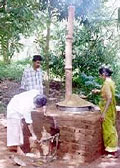
In Kerala, India, more than half a million homes now have Parishad ovens -- high-efficiency wood burning stoves which use at least 50% less firewood, saving 0.6-0.8 million tons of firewood a year. |
Improved stoves
Improved stoves save fuel and cut health-damaging indoor smoke pollution. Almost every country in Asia has its own improved cook stoves program. In 15 years India's program has distributed nearly 30 million improved chulha clay stoves to rural and semi-urban households (with 90 million households to go). Each new stove can save the equivalent of 210 kg of coal/soft coke a year, or 40 litres of kerosene, a huge overall saving.
"Improved Solid Biomass Burning Cookstoves: A Development Manual" by Prof. S.K. Sharma, Director of the Energy Research Centre of Punjab University, Field Document No. 44, 1993, FAO Regional Wood Energy Development Program in Asia -- Basic information on the development and dissemination of improved cookstoves, for field workers and others. 125-page manual covers History, Principles of Improved Cookstove Design and Development, Wood and Biomass, Improved Cookstove Technologies, Environmental and Health Implications, The Kitchen, Improved Cookstoves as Combined Technology, Future Needs, Bibliography and Appendix (Chimneys).
http://144.16.93.203/energy/HC270799/RWEDP/fd44.html
Download the manual (Acrobat file, 943kb):
http://144.16.93.203/energy/HC270799/RWEDP/acrobat/fd44.pdf
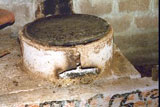
Mirte improved stoves in Ethiopia halve wood consumption and vacate the smoke (Mike Bess, Energy for Sustainable Development, UK)
|
The thermal efficiency of the improved stoves is 25-35%, compared to only 6-10% for traditional stoves. But even the improved stoves aren't very efficient -- they could be up to three times more efficient, saving an enormous amount of energy (trees), and cutting pollution and greenhouse gas emissions at the same time, with big savings for poor households.
"It is not impossible to have a biomass cook stove with total combustion and an approachable efficiency of around 65%, and also made available at an affordable cost," says Prof. P.D. Grover of the Indian Institute of Technology in Delhi. He says a "Dream Stove" would cost from US$8-12, or less with mass production and the use of local materials. See "Cost Estimates For A 'Dream Stove' For Asia":
http://www.repp.org/discussiongroups/resources/
stoves/Grover/paper-grover.htm
Biomass Cooking Stoves -- Resources page for the Renewable Energy Policy Project (REPP) Stoves Mailing List discussions. "This site exists to help people develop better stoves for cooking with biomass fuels in developing regions." Worldwide Stoves A to Z, Stoves By Country, and much more. The best website on all aspects of cookstoves.
http://www.repp.org/discussiongroups/resources/stoves/
Gallery of Cook Stoves (2003), with links to papers on design, techniques and more.
http://www.repp.org/discussiongroups/resources/stoves/gal2003.htm
Gallery of Cooking Stoves: Gallery of Current Work (2002)
http://www.repp.org/discussiongroups/resources/stoves/gallery.html
Improved Cookstoves and Charcoal Production -- "The Appropriate Technology Sourcebook: A Guide to Practical Books for Small Community Technology" by Ken Darrow and Mike Saxenian, revised and enlarged edition, 1993, Consortium for Sustainable Village Based Development (CSVBD) ISBN 0917704185. This section of the Sourcebook has reviews of 37 books on improved cookstoves and charcoal production covering all aspects of the subject from design to community acceptance, along with a concise but thorough 1,000-word overview of the problems, constraints and solutions. It includes some wise cautions. For instance, you might assume that the less smoke the better, but you might be wrong: "In many places, smoke from indoor cooking fires is a significant contributor to lung and eye disease. Yet this smoke also serves to dry crops hung over the cooking area and to protect thatched roofs from insect damage". It's best to assume that your assumptions could be wrong. The reviews are pithy and to-the-point, with sources for the books and prices. Reading the whole section (about 8,000 words) will give you a good introduction to this promising but far from simple field of work. Online at publishers Village Earth/CSVBD:
http://www.villageearth.org/pages/Appropriate_Technology/
ATSourcebook/Energycookstoves.php
Village Earth's Appropriate Technology Library has the complete text and images from over 1,050 of the best books on all areas of do-it-yourself technologies, over 150,000 pages in digitized format, on Mac and PC compatible CD-ROMs or DVDs.
- CD-ROM #14: Energy: General and Energy: Cookstoves -- A Woodstove Compendium. Covers wood-burning cookstove design and construction, testing procedures, evaluating fuel consumption, charcoal making, different fuels, and much more.
- CD-ROM #15: Energy: Cookstoves Cont. & Energy: Wind -- Improved Stoves, Comparisons, Indoor Smoke Pollution, Splitting Firewood, Markets, Testing Timber for Moisture, Improved Pit-Kiln for Charcoal, the Jiko, and more.
From Village Earth:
http://www.villageearth.org/Publications/ATLibrary/ATLCDs.html
"Cookstoves for the Developing World" by Daniel M. Kammen of Princeton University, Scientific American, 1995 -- "Traditional wood, charcoal and coal stoves are used in hundreds of millions of homes. Their redesign can have a dramatic effect on energy usage, the environment and community health." Good overview.
http://socrates.berkeley.edu/~kammen/cookstoves.html
Rice-husk stoves -- The Manufacture of a Cement Extender from Rice-Husks using a Basket-Burner, by M. L. Allen -- Rice husk ash gives a range of good castable insulating and semi- refractory blocks when mixed with cement and water (12:1 to 3:1) -- ideal for making low-cost wood or charcoal stoves.
Wood-gas stoves
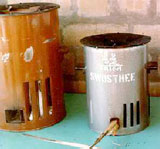
Swosthee wood-gas stoves in Malaysia |
Wood-gas cooking stoves are perhaps the best answer so far. These are gasifiers that produce gas from wood and then burn the gas, leaving charcoal (itself a useful fuel). They're clean, fast and efficient. They burn small pieces of wood, sticks, wood chips, corncobs or nutshells, producing a clean, blue flame and no smoke. A lot of cunning engineering has gone into the development of these stoves, and yet they're easily made from locally available materials -- even tin cans.
Technically, they're called "inverted downdraft gasifier" stoves, operating on natural convection. How wood-gas stoves work: See A Wood-gas Stove For Developing Countries, T. B. Reed and Ronal Larson (268k Acrobat file). 300g of sticks or chips burn for 30-45 minutes at high efficiency with low emissions.
Wood Gas -- The Biomass Energy Foundation's Home Page
http://www.woodgas.com/
The "Turbo" is a wood-gas, adjustable heat, cooking stove that burns small pieces of wood or other biomass fuels such as nut shells, corn cobs, etc. A clean burning stove that can be used indoors with only minimal ventilation and cooks as fast as a modern gas or electric stove. 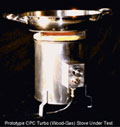 It can boil 500 ml of water in 3.5 minutes, comparable to an electric or gas stove. It uses a 3 Watt blower and develops 3 kilowatts of heat. See Testing & Modeling the Wood-gas Turbo Stove, T. B. Reed, E. Anselmo and K. Kircher (Acrobat file, 296k). It can boil 500 ml of water in 3.5 minutes, comparable to an electric or gas stove. It uses a 3 Watt blower and develops 3 kilowatts of heat. See Testing & Modeling the Wood-gas Turbo Stove, T. B. Reed, E. Anselmo and K. Kircher (Acrobat file, 296k).
We made a prototype wood-gas stove out of two 400g tomato cans. One had lots of holes punched in the bottom and a sort of slider affair to control the air supply; the second can had no bottom and fitted on top of the first can, with a small gap. We filled the bottom can with small bits of wood, stacked upright, lit it with some tinder on top and put the second can on. The fire immediately stopped smoking and produced a clean, hot gas flame. It burned for half an hour, and left us with a pile of nice charcoal sticks.
We don't know how else you'd get so little wood (only 120 grams, 4 ounces) to burn that long and that hot, and leave you with a fuel supply in the end..
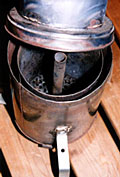 For comparison we made an ordinary fire with the same amount of wood. It burned for only 10 minutes, smoked a lot, and left some unreusable ash and coals. Then we tried the charcoal from the stove: it burned nicely for 25 minutes without any smoke, leaving a small pile of ash. These stoves really work! -- 10 minutes of a smoky, flaming, energy-wasting wood fire, vs 55 minutes with stove and charcoal, no smoke, and much less residue. For comparison we made an ordinary fire with the same amount of wood. It burned for only 10 minutes, smoked a lot, and left some unreusable ash and coals. Then we tried the charcoal from the stove: it burned nicely for 25 minutes without any smoke, leaving a small pile of ash. These stoves really work! -- 10 minutes of a smoky, flaming, energy-wasting wood fire, vs 55 minutes with stove and charcoal, no smoke, and much less residue.
Our third prototype was much improved, with some innovations, though it's still far from perfect -- see Cookstoves for schools -- A wood-gas stove made from three tin cans.
Stoves Mailing List -- Discussion of biomass cooking stoves
Stoves List Website:
http://listserv.repp.org/mailman/listinfo/stoves_listserv.repp.org
Stoves List Archives — Prior to 2003:
http://www.repp.org/discussion/stoves/200201/
2003 Forward:
http://listserv.repp.org/pipermail/stoves_listserv.repp.org/
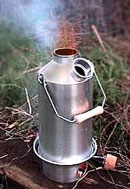
Volcano kettle
|
Other simple and effective stoves:
The Hobo Stove
TrailStove
Volcano kettle
Backpack stove
Scott Henderson's Pepsi Stove
http://wings.interfree.it/html/Pepsi.html
The Home Made Stove Archives
http://wings.interfree.it/index.html
SuperShioshio lives in Yokohama in Japan, he's a mountaineer and he collects backpack camping stoves. "I seem to be attacked by stoves," he says -- he has more than 200 of them, stoves of every possible type, all on display at his website.
http://www.asahi-net.or.jp/~we2a-sod/index.htm
Charcoal
Charcoal is second only to wood as a Third World fuel. It's half the price of kerosene, a quarter the price of LPG or electric power. It burns without smoke, stores well without rotting, for the producers it's much lighter than wood and easier to transport, and producing it keeps many thousands in work. And it's a high-energy fuel -- ideal for local blacksmiths' forges and for small industry.
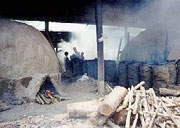
Traditional charcoal kiln (RWEDP) |
An old reference (source unknown) says: "One lb. of charcoal will boil away 13 lbs. of water, whereas the same weight of Newcastle coal will boil away only 8 or 9 lbs. A pound of coke will only boil away 4 lbs. of water, and a pound of peat seldom more than 5 lbs., or, by a skilful mode of using it, at the utmost 10 lbs."
But it's still a wasteful fuel -- cooking with charcoal uses much more wood than cooking with firewood. Burning wood to make charcoal wastes energy and causes pollution, and most Third World charcoal production is inefficient.
Like firewood, the demand for charcoal is growing, and cannot be stopped. Again, there are large savings to be made with more efficient cooking stoves, and also by improving the efficiency of charcoal production.
See:
Burning Charcoal Issues, Robert van der Plas, The World Bank Group, FPD Energy Note No. 1, April 1995 (332kb pdf)
http://snipurl.com/16ns3
Charcoal and its Socio-Economic Importance in Asia: Prospects for Promotion, Tara Bhattarai, Wood Energy Resources Specialist, RWEDP (84kb pdf)
http://www.rwedp.org/acrobat/p_charcsocio.pdf
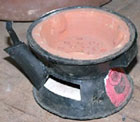 Over 300,000 Lakech improved charcoal stoves have been sold in Ethiopia -- 35% efficiency improvement at US$1 each (Mike Bess, Energy for Sustainable Development, UK) Over 300,000 Lakech improved charcoal stoves have been sold in Ethiopia -- 35% efficiency improvement at US$1 each (Mike Bess, Energy for Sustainable Development, UK)
|
Wood gas as motor fuel
See Wood gas as motor fuel
Resources
FAO Regional Wood Energy Development Program in Asia (RWEDP): "Growing Demand for Wood Energy"
http://144.16.93.203/energy/HC270799/RWEDP/index.html
RWEDP Publications: Data, Planning and Policies, Resources, Conversion, Utilisation (Stoves, Industries), Woodfuel Flows and Trade, Gender, Environment, and more
http://144.16.93.203/energy/HC270799/RWEDP/public.html
RWEDP Documents for Download: Field Documents, Reports and Miscellaneous Documents, Wood Energy News, Additional Papers -- Texts of presentations, lectures, etc
http://144.16.93.203/energy/HC270799/RWEDP/download.html
RWEDP: Issues in Wood Energy -- major issues in wood energy, with a comprehensive overviewand links to related issues and publication. Covers Utilization, Supply, Planning and more.
http://144.16.93.203/energy/HC270799/RWEDP/issues.html
Can a small NGO match a huge multinational oil company when it comes to reducing greenhouse gas emissions? Dr. W.S. Hulscher, Chief Technical Adviser for the Regional Wood Energy Development Program in Asia (RWEDP), compares the effects of a local NGO distributing 15,000 improved wood and charcoal stoves a year in Laos with the potential of a large production facility for photovoltaic solar energy panels built by Shell in Europe -- with surprising results: they're equal. "Solar electricity is 1,000 times more expensive than cooking on wood," he adds. See The Battle in the Greenhouse.
Modern Stoves for All, Waclaw Micuta, revised edition, ISBN 9780946688357. Practical survey of low-cost stoves for use in developing countries. For skilled technicians able to use the drawings as a basis for building stove models, for testing and adaptation to local conditions. Download free from Alex Weir's CD3WD 3rd World online library (12.3 Mb pdf)
http://www.fastonline.org/CD3WD_40/JF/425/20-453.pdf
Improved Wood Waste and Charcoal Burning Stoves: A practitioners manual, W. Stewart and others, ISBN 9780946688654. Describes the chief characteristics, both advantages and disadvantages, of 28 types of stoves. Download free from Alex Weir's CD3WD 3rd World online library (20.1 Mb pdf):
http://www.fastonline.org/CD3WD_40/JF/425/20-484.pdf
The Kenya Ceramic Jiko: A manual for stovemakers -- Hugh Allen, ISBN 9781853390838. Guidance on the production and promotion of the jiko, a charcoal-burning stove with a ceramic liner inside a metal case which burns 25-40% less charcoal than the traditional stoves the design is based on. Download free from Alex Weir's CD3WD 3rd World online library (11.4 Mb pdf):
http://www.fastonline.org/CD3WD_40/JF/425/20-480.pdf
"Portable Metallic Cookstoves", Industry Profile #12, Understanding Technology Series, Volunteers in Technical Assistance (VITA), 1988, ISBN 0-86619-299-9
Guide for local artisans or small-scale local industries to manufacture a wood-saving, money-saving, wood-burning cookstove which uses a small amount of wood and cooks rapidly. Reduces wood use and cooking times by about half. Can be made from new or recycled sheet steel (such as cut-up oil drums) by anyone with a hammer and chisel. Designed to reduce the use of fuelwood in response to deforestation of such areas as the West African Sahel. Full text online:
http://www.cd3wd.com/cd3wd_40/vita/stovport/en/stovport.htm
Briquette Presses for Alternate Fuel Use, by Jason Dahlman with Charlie Forst, 2001 -- Design for a simple briquette press that can also be used as an oil press for seeds. Acrobat file, 2.8Mb
http://www.echotech.org/technical/technotes/Briquete.pdf
"Come home to wood heat, it's good for you." The Wood Heat Organization is a non-profit NGO dedicated to the responsible use of wood as a home heating fuel. Incorporated in Canada and still with a North American focus, its objective is to provide useful information to anyone who uses wood for home heating, wherever in the world they live. "Wood is an effective, renewable energy source for household heating and cooking when sustainable forestry methods are used for fuel supply and when the fuel is burned using appropriate technologies and techniques." Why heat with wood? -- woodburning technologies -- hearths -- chimneys -- firewood -- safety -- tips and techniques -- environment -- lore.
http://www.woodheat.org/index.htm
"Top down fever -- a new (old) fire-building technique": the top-down technique is the counter-intuitive opposite of the usual way of building fires, but it works, and works better, with much less smoke.
http://www.woodheat.org/tips/topdown.htm
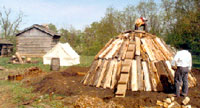
"Fuel For The Fires: Charcoal Making in the Nineteenth Century", Chronicle of the Early American Industries Association (June, 1994).
http://www.connerprairie.org/
historyonline/fuel.html
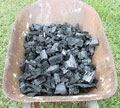 How to make charcoal at home -- using a 55-gallon oil drum: full instructions, with further information and links. How to make charcoal at home -- using a 55-gallon oil drum: full instructions, with further information and links.
http://www.velvitoil.com/Charmake.htm
Making your own charcoal -- simple step-by-step instructions with diagrams using an oil drum.
http://www.eaglequest.com/~bbq/
charcoal/index.html
Appropriate technology
Appropriate technology resources
- Agriculture resources
- Wood resources
Blacksmithing
Wood fires that fit
Houses that fit
Water-powered water pumps
Journey to Forever and AT
- Chinese watering cans
- Handmade Projects watering can plans
- Hoe for victory!
- Billhooks and sickles
A better rat trap
- Rats and owls
- Chinese rat trap
- How to make a Chinese rat trap
- Bucket rat trap
Appropriate technology subjects
|

![]()

 Indoor smoke causes pneumonia and other respiratory infections, the biggest killer of children under five years of age. Indoor air pollution is responsible for nearly half of the more than 2 million deaths each year that are caused by acute respiratory infections. Inheriting the world: The atlas of children's health and the environment, by Bruce Gordon, Richard Mackay and Eva Rehfuess, WHO 2004, gives a graphic view of the problem. See Chapter 9, "Indoor Smoke: Breaking Down Respiratory Defences" (pdf 498kb):
Indoor smoke causes pneumonia and other respiratory infections, the biggest killer of children under five years of age. Indoor air pollution is responsible for nearly half of the more than 2 million deaths each year that are caused by acute respiratory infections. Inheriting the world: The atlas of children's health and the environment, by Bruce Gordon, Richard Mackay and Eva Rehfuess, WHO 2004, gives a graphic view of the problem. See Chapter 9, "Indoor Smoke: Breaking Down Respiratory Defences" (pdf 498kb): Indoor smoke pollution now ranks 8th in health burden worldwide (lost years of healthy life), and ranks fourth in the "least-developed" countries (which make up about 40% of the world population), according to the World Health Organization's World Health Report 2002. "Half the world's population is exposed to indoor air pollution, mainly the result of burning solid fuels for cooking and heating. Globally, it is estimated to cause 36% of all lower respiratory infections and 22% of chronic obstructive pulmonary disease." See World Health Report 2002:
Indoor smoke pollution now ranks 8th in health burden worldwide (lost years of healthy life), and ranks fourth in the "least-developed" countries (which make up about 40% of the world population), according to the World Health Organization's World Health Report 2002. "Half the world's population is exposed to indoor air pollution, mainly the result of burning solid fuels for cooking and heating. Globally, it is estimated to cause 36% of all lower respiratory infections and 22% of chronic obstructive pulmonary disease." See World Health Report 2002: Smoke -- the killer in the kitchen: Smoke in the home from cooking on wood, dung and crop waste kills nearly one million children a year. The total annual death toll is 1.6 million -- a life lost every 20 seconds. Acute respiratory infections, ear and eye problems, breathlessness, chest pains, headaches and giddiness are just some of the symptoms poor woman and children suffer in their homes. Smoke -- the Killer in the Kitchen: Indoor Air Pollution in Developing Countries, Practical Action, 2004:
Smoke -- the killer in the kitchen: Smoke in the home from cooking on wood, dung and crop waste kills nearly one million children a year. The total annual death toll is 1.6 million -- a life lost every 20 seconds. Acute respiratory infections, ear and eye problems, breathlessness, chest pains, headaches and giddiness are just some of the symptoms poor woman and children suffer in their homes. Smoke -- the Killer in the Kitchen: Indoor Air Pollution in Developing Countries, Practical Action, 2004:


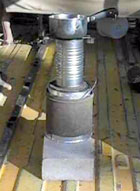
 It can boil 500 ml of water in 3.5 minutes, comparable to an electric or gas stove. It uses a 3 Watt blower and develops 3 kilowatts of heat. See Testing & Modeling the Wood-gas Turbo Stove, T. B. Reed, E. Anselmo and K. Kircher (Acrobat file, 296k).
It can boil 500 ml of water in 3.5 minutes, comparable to an electric or gas stove. It uses a 3 Watt blower and develops 3 kilowatts of heat. See Testing & Modeling the Wood-gas Turbo Stove, T. B. Reed, E. Anselmo and K. Kircher (Acrobat file, 296k). For comparison we made an ordinary fire with the same amount of wood. It burned for only 10 minutes, smoked a lot, and left some unreusable ash and coals. Then we tried the charcoal from the stove: it burned nicely for 25 minutes without any smoke, leaving a small pile of ash. These stoves really work! -- 10 minutes of a smoky, flaming, energy-wasting wood fire, vs 55 minutes with stove and charcoal, no smoke, and much less residue.
For comparison we made an ordinary fire with the same amount of wood. It burned for only 10 minutes, smoked a lot, and left some unreusable ash and coals. Then we tried the charcoal from the stove: it burned nicely for 25 minutes without any smoke, leaving a small pile of ash. These stoves really work! -- 10 minutes of a smoky, flaming, energy-wasting wood fire, vs 55 minutes with stove and charcoal, no smoke, and much less residue.

 Over 300,000 Lakech improved charcoal stoves have been sold in Ethiopia -- 35% efficiency improvement at US$1 each (Mike Bess, Energy for Sustainable Development, UK)
Over 300,000 Lakech improved charcoal stoves have been sold in Ethiopia -- 35% efficiency improvement at US$1 each (Mike Bess, Energy for Sustainable Development, UK)
 How to make charcoal at home -- using a 55-gallon oil drum: full instructions, with further information and links.
How to make charcoal at home -- using a 55-gallon oil drum: full instructions, with further information and links.